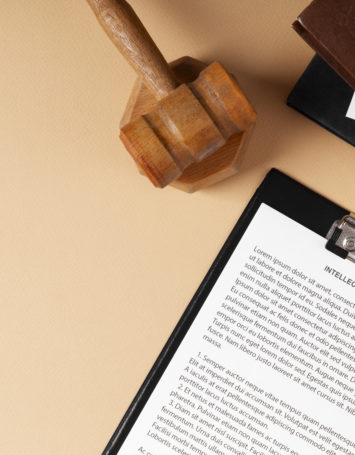Article written by Clyde Shuman
The U.S. Court of Appeals for the Federal Circuit, in a precedential opinion, held that applicant admitted prior art (AAPA) did not constitute “prior art consisting of patents or printed publications,” as required in an inter partes review (IPR) proceeding, under 35 U.S.C. § 311(b). In Qualcomm Inc. v. Apple Inc., Appeal Nos. 2020-1558, 2020-1559, the Court held that the Patent Trial and Appeal Board (Board) erred in relying in part on AAPA to find claims of Qualcomm, Inc.’s patent unpatentable as obvious under 35 U.S.C. § 103. The Court vacated the Board’s decision and remanded for determination whether the IPR petition of Apple, Inc. raised a § 103 challenge to the claims at issue “on the basis of prior art consisting of patents or printed publications.” § 311(b) (emphasis added by Court).
By way of background, Qualcomm was the owner of a patent directed to integrated circuit devices with power detection circuits for systems with multiple supply voltages. Qualcomm’s patent described “level shifters” that communicate between the input/output devices and the core devices. When the core devices are powered down, the connection between the core and input/output network through the level shifters could lead to problems, e.g., stray currents causing the level shifters to trigger the input/output devices for transmission resulting in erroneous output signals from the circuit.
The patent described a prior art method to remedy the stray current problem, disclosing that power-up/down detectors can be used to generate a power on/off-control (POC) signal internally that instructs the input/output devices when the core devices are shut down. The patent described avoiding problems associated with the prior art solution, viz., by adding a feedback network to increase detection speed.
Apple filed two IPR petitions against Qualcomm’s patent based on the same two grounds but each challenging different sets of claims. In ground 1, Apple challenged the claims as unpatentable under § 103 in view of three prior art references (two patents and a printed publication).
Apple’s second ground relied on applicant admitted prior art (AAPA), namely, Figure 1 of the Qualcomm patent and its accompanying description in the patent, in view of a prior art patent publication (Majcherczak).
Qualcomm conceded that the combination of AAPA and Majcherczak teaches each element of the challenged claims, but challenged Apple’s use of AAPA in the IPR proceeding. Qualcomm argued that such patent owner admissions cannot be used to challenge the validity of a patent in inter partes review. The Board disagreed, concluding that under 35 U.S.C. § 311(b), “prior art consisting of patents or printed publications” includes AAPA because it is prior art contained in a patent. Having decided that Apple’s use of AAPA was proper under the statute, the Board found that the AAPA in combination with Majcherczak rendered the challenged claims unpatentable as obvious.
On appeal, the Court began by discussing, inter alia, the guidance of the Director of the USPTO in “Treatment of Statements of the Applicant in the Challenged Patent in Inter Partes Reviews Under § 311(b)” (Guidance). The Court noted that the Guidance agrees with Qualcomm that AAPA does not fall within “prior art consisting of patents or printed publications” under § 311(b). However, the Guidance reads Federal Circuit precedent to permit the use of AAPA in inter partes review as evidence of the general knowledge of a skilled artisan. The Guidance concludes that AAPA, like knowledge of a skilled artisan, may be used to include supplying a missing claim limitation or supporting a motivation to combine.
In this case, the AAPA played such a significant role in the validity challenge that it formed “the basis” of the ground.
The Federal Circuit, for its part, emphatically and unequivocally held that AAPA does not constitute “prior art consisting of patents or printed publications” under § 311(b) such that it may form “the basis” of a ground in inter partes review.
The Court noted that the express language of § 311(b) limits “the basis” of any “ground” in an inter partes review to “prior art consisting of patents or printed publications.” The Court thus agreed with Qualcomm and the PTO that the “patents or printed publications” that form the “basis” of a ground for inter partes review must themselves be prior art to the challenged patent, and excludes any descriptions of the prior art contained in the challenged patent. Per the Court, “This interpretation is consistent with prior judicial interpretations of the statute and represents a more natural reading of § 311(b).”
The Court explained, “In other words, § 311(b) does not permit AAPA in this case to be the basis of a ground in an inter partes review, because it is not contained in a document that is a prior art patent or prior art printed publication.”
The Court cautioned that, even though AAPA contained in the challenged patent is not “prior art consisting of patents or printed publications,” it does not follow that AAPA is categorically excluded from an IPR. Citing its 2020 decision in Koninklijke Philips N.V. v. Google LLC, 948 F.3d 1330, 1339 (Fed. Cir. 2020), the Court said, “We have held that ‘it is appropriate to rely on admissions in a patent’s specification when assessing whether that patent’s claims would have been obvious’ in an inter partes review proceeding.” Per the Court, this is because a petitioner may rely on evidence beyond prior art documents in an IPR, even if such evidence does not itself qualify as the ”basis” for a ground set forth in a petition. Referring again to its 2020 decision in Koninklijke Philips, the Court noted that it there specifically rejected an argument that the general knowledge of a skilled artisan may not be relied on in an IPR because it does not constitute “prior art consisting of patents or printed publications” under § 311(b).
Per the Court, “As a patentee’s admissions about the scope and content of the prior art provide a factual foundation as to what a skilled artisan would have known at the time of invention, it follows that AAPA may be used in similar ways in an inter partes review,” including, e.g., furnishing a motivation to combine or supplying a missing claim limitation.
The Court also said that the use of AAPA in an IPR proceeding is consistent with its understanding that Congress sought to create a streamlined administrative proceeding that avoided some of the more challenging types of prior art identified in 35 U.S.C. § 102, such as commercial sales and public uses, by restricting the “prior art” which may form a basis of a ground to prior art documents.
Restating its two-pronged holding that (i) the Board incorrectly interpreted § 311(b)’s “prior art consisting of patents or printed publications” to encompass AAPA contained in the challenged patent, but (ii) the use of AAPA can be permissible in an IPR, the Court remanded to allow the Board to address with AAPA whether AAPA improperly formed the “basis” of Apple’s challenge to Qualcomm’s claims, an issue not addressed in the Board’s final written decision.
The Court assessed costs to Qualcomm.



